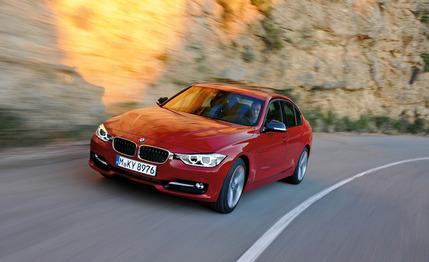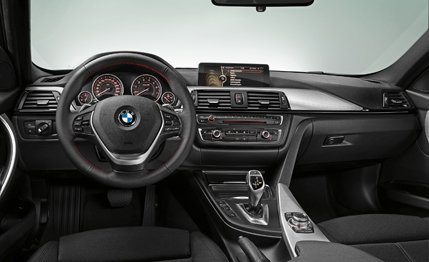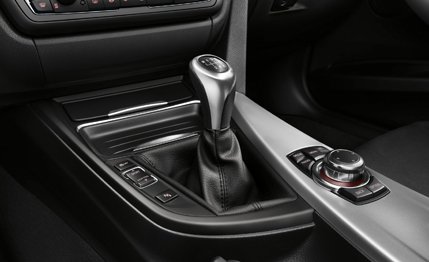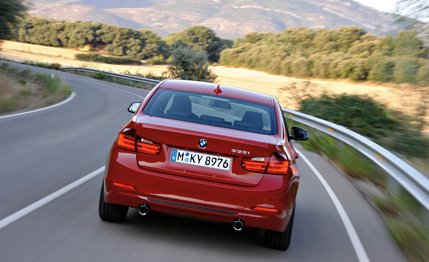
 Instrumented Test
Instrumented Test


If you’re like us, you’ve bored holes through pictures of the new 3-series sedan trying to discern the styling changes versus the outgoing model. Yes, there are some. A new face features headlights that puddle in toward the chrome-wrapped kidneys and a broad, blunt-faced front bumper that creates a sort of grimacing overbite into the lower grille. Move around to the sides and tail, and it all looks very familiar, even though the new car is 1.9 inches longer in wheelbase and 3.7 inches longer overall, which gives it more of a sleek, sprinter-on-blocks profile. But what’s really new about the F30, you ask? Well, after 600 miles in a brand-new 2012 F30-generation 335i Sport Line—and a couple of plates of South Carolina barbecue—we have a pretty good idea.
The turbocharged N55 3.0-liter inline-six carries over its silkworm-woven symmetrical outputs of 300 hp and 300 lb-ft of torque. The six-speed manual still operates in concert with a tautly sprung clutch pedal and a spindly shifter that moves with greased precision, and the suspension and steering still make us smile. The differences are in the details: The dash controls and vents stay in roughly the same locations, but a welcome redesign of the panel—with its more pronounced instrument hood, driver-oriented center console, and traditional pull-type parking brake—concentrates the focus on the pilot. The Sport Line (the flashiest of three available trim packages) offers a decorous marriage of leather, metal, red stitching, and low-gloss plastic.
The wheelbase punch-out creates a few more cubic feet here and there, most noticeably in the back seat with its extra head and knee room, plus some subtle tactile difference in the steering, no doubt due to the switch to electric assist (more on that in a second). The 2012 335i’s base price rises merely $370 from the 2011 model’s, and the weight gain from our last E90 335i test car is 77 pounds, at least some of which must be from the new optional 19-inch wheels ($900) and run-flat tires.
As Porsche did with its overhauled 911, BMW played it safe, not so much redesigning its icon but giving it a scrub and polish.
The company has laid to rest the bad memories of its original iDrive and brought forth an easily navigated multimedia system, though the 3’s new freestanding center display doesn’t retract, and it matches the surrounding landscape about as well as the screen in a desert drive-in theater.


The 335i loves being hurried down country two-lanes with a radar detector on guard, showing the same easy comfort with a quick pace as the previous model did. If the definition of good steering is that which allows the driver to place the car exactly where desired, the 335i’s still got it. Its clarity is undimmed by the switch to electric assist and a new, optional variable-ratio steering gear, even if its feedback is more opaque. Surface textures and impacts are indeed tuned out by this rack-and-pinion setup (though not by the body’s sound insulation, which lets a surprising amount of tire noise through), but the sense of control doesn’t really diminish.
The on-center window of slackness is just wide enough to hold the car on a straight path but not too wide or too dead—as we’ve noticed in the 5- and 7-series—to allow wandering. Meanwhile, the effort rises gratifyingly as you turn in. Unless you’re the type that likes wheel shudders through every apex, the new 3 leaves little to complain about.
The wheel does feel a little overassisted with the Driving Dynamics Control (DDC) console switch—which this year finds its way from BMW’s bigger cars into the 3-series as standard equipment—set on Comfort. But bump it up to Sport or Sport +, and a natural heft returns. There’s also an Eco Pro setting that waters down the throttle response to something closer to that of a Toyota Corolla.


We can’t say definitively that you need the optional Adaptive M suspension ($900), which adds electronically variable-damping shocks to the functions controlled by the DDC. For decades, the 3-series has gotten by fine without wires to its suspension. But we never found a setting, which varies depending on what DDC mode you’re in, that reduced either the ride quality or body control below that of excellent. Even in the Sport and Sport + modes, which perk up the throttle—and in the latter also cuts traction-control intervention—the suspension still weeds out the worst chop. The suspension option does give the 3’s character some flexibility. If you like your 3 to always be in hunt-kill mode, an optional M Sport package, coming later, will drop the ride height by 0.4 inch on firmer, non-electronic shocks, stiffer springs, and thicker anti-roll bars.
As for the numbers, the 335i proved marginally slower than expected in testing. It needed 5.3 seconds to reach 60 mph instead of something in the high fours, as we’ve recorded with previous 335s. Sometimes that’s the driver’s fault, but forensic analysis revealed that the launches came off okay. However, the car then slowed appreciably even though the shifts were clean. We even tried power-shifting (keeping the gas pedal floored during the gearchanges) a couple of times, but the numbers wouldn’t budge.


A slower 5-to-60 time of 5.9 seconds—we expected mid-fives for that—also indicated that something may have been amiss. Bad gas, perhaps, or not enough break-in miles on the odometer (1365 at test time). Possibly, the new 19-inch rims and correspondingly heavier tires may have helped act as anchors. The 3’s other anchors, the brakes, did their duty to perfection, pulling several stops between 164 and 170 feet and never failing to offer a firm pedal in any situation.
The upshot is that the 3-series marches on with improvements that mostly require engineering drawings to ascertain. This is either good news if you passionately adored the previous model or bad tidings if you were hoping for more newness. At some point, BMW will have to take a bigger step to move forward or risk falling behind its competitors—but not just yet.